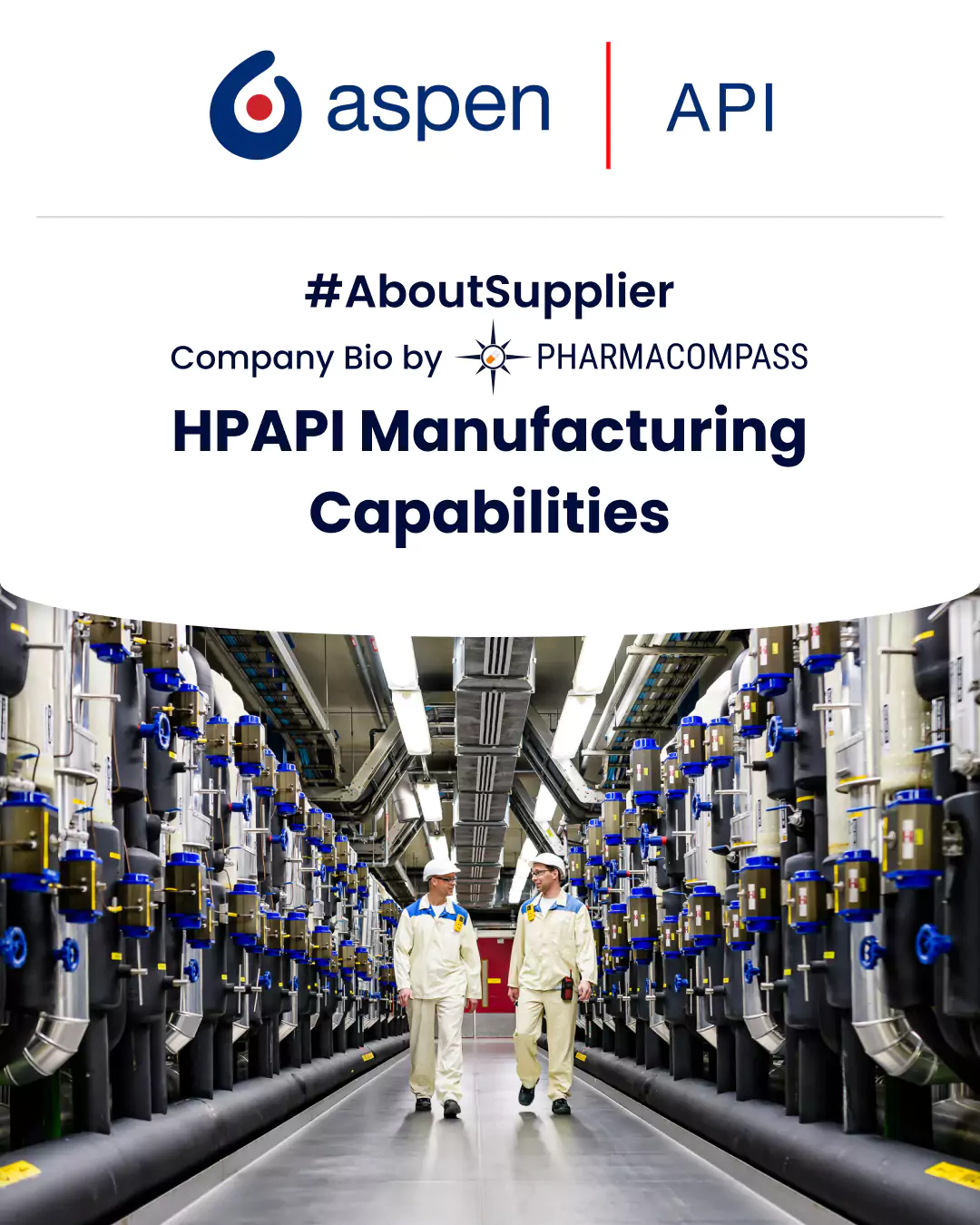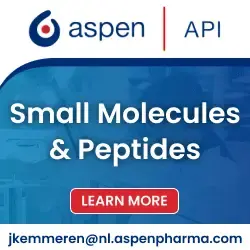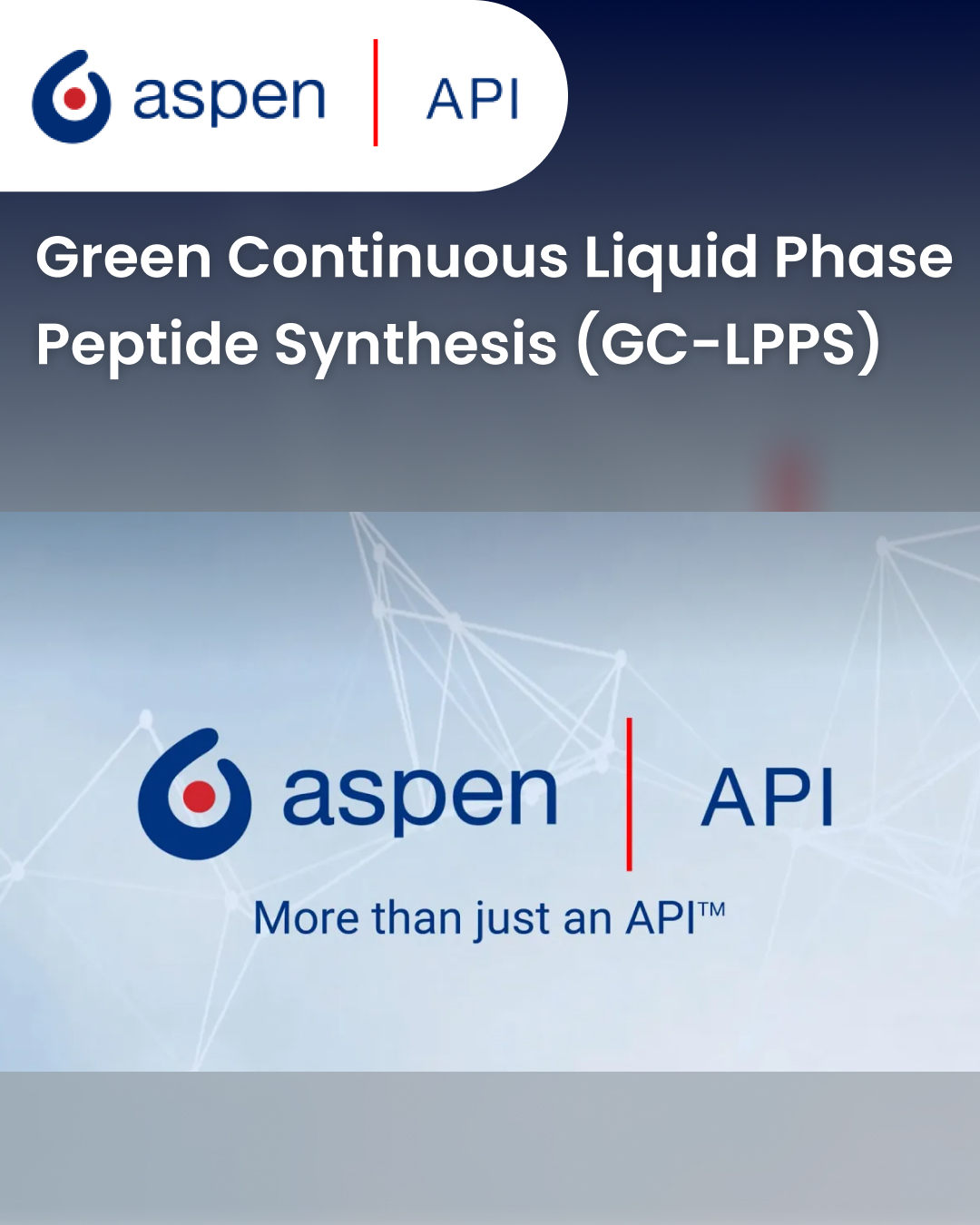
By PharmaCompass
2022-07-26
Impressions: 1953
Overview of high potency APIs or HPAPI contract manufacturing services & more on Aspen API's CDMO services for cytotoxic HPAPIs on PharmaCompass.
Q1. What is a highly potent API (HPAPI)?
Highly potent active pharmaceutical ingredient (HPAPI) is a compound that elicits a biological response at a much smaller dose, such as a daily therapeutic dose of <10 mg. High potency drugs have the ability to bind selectively at low doses to specific receptors or inhibit specific enzymes as part of cancer or hormonal therapies.
High-potency APIs (HPAPIs) require multi-step processes or semi-synthesis along with special handling requirements due to toxicity. HPAPI development and production require specialized considerations in facility design, equipment, operation and process safety to achieve the requisite level of containment. It also presents major handling challenges for innovators and manufacturing companies.
High-potency APIs (HPAPIs) are becoming increasingly popular and companies are now looking for flexible containment solutions to help address their needs. However, if the current HPAPI development continues to show more efficacy, high potent API is likely to become one of the most dominant areas in the industry. High potency API (HPAPI) is prominent in oncology research and hence represents an increasingly significant share of the pharmaceutical drug pipeline.
Because a growing number of pharmaceutical products contain highly potent active pharmaceutical ingredients (HPAPI) , demand for the production of HPAPIs has increased. Estimates suggest the global HPAPI market will register a strong growth over the next 5-10 years. In addition to cancer, highly potent API (HPAPI) is being used in hormonal imbalance drugs, cardiovascular drugs, central nervous system drugs and musculoskeletal drugs.
The challenges in HPAPI manufacturing have also increased, along with investments, in terms of specialized containment areas and procedures to prevent personnel and environmental exposure. A pharmaceutical CDMO has the capability to offer highly potent small molecule development services and HPAPI Contract Manufacturing Services.
Integrated CDMOs have capabilities to offer both production & development services for highly potent APIs (HPAPIs), and to scale-up for HPAPI (highly potent API) development from lab quantities to large-scale volumes. The main advantage of outsourcing HPAPI contract manufacturing services is that it eliminates the need to invest in costly containment infrastructure that can also be difficult to engineer, install and maintain and it can offer HPAPIs, ADCs, highly potent small molecule development services along with manufacturing.
Q2. How are the different containment challenges addressed for high-potency APIs (HPAPIs)?
HPAPI can be a small-molecule, a biologic, or a hybrid of two molecules, such as an antibody-drug conjugate that links a cytotoxic small molecule to a monoclonal antibody. The cytotoxic nature of highly potent APIs presents significant challenges in terms of safe handling and containment during process scale-up and development, clinical and large-scale production of highly potent APIs (HPAPIs). Hence, HPAPIs require heavy investments for the implementation of specialized containment facilities.
Additionally, the cGMP manufacturing of high-potency active pharmaceutical ingredients (HPAPIs) requires an isolated environment that is equipped with isolators and cleanrooms. Working with an experienced pharmaceutical outsourcing organization such as a CMO or CDMO for contract manufacturing of highly potent compounds can help eliminate challenges like investing in expensive infrastructure and the cost of training staff for the production of a highly potent API (HPAPI). Such outsourcing organizations can also offer highly potent intermediates and active pharmaceutical ingredients, ADCs, biologics, large molecule, highly potent small molecule development services along with other contract manufacturing services.
HPAPI containment challenges can be handled through the following ways:
- A manufacturer of HPAPIs should consider several areas in order to safely manage high potency active pharmaceutical ingredient (HPAPI) processes. For successful HPAPI (highly potent API) development, extensive knowledge and experienced staff are required. Relevant training should be provided to the staff. The training should also feature in-depth information on every step of the handling process, equipment use and unit operations.
- Employee exposure to high potent active pharmaceutical ingredients (HPAPIs) is typically the primary concern for manufacturers. As such, it is essential to put a thorough cleaning program in place to avoid contaminating surfaces. If an undesired event occurs, manufacturers of highly potent intermediates and active pharmaceutical ingredients should have a response plan to work from, indicating appropriate reaction from employees to an unplanned incident.
- Highly potent active pharmaceutical ingredients (HPAPIs) have a specific occupational exposure limit (OEL) that must be kept in mind to ensure safe handling, as there is a selective process in choosing the most appropriate containment strategy. An occupational physician should work closely with the committee, regulatory authorities and any relevant health and safety bodies. Inadequate containment of high potent API (HPAPI) can decrease product yields or cause cross-contamination of the final product.
- One of the largest areas for consideration is equipment. All HPAPI handling and development systems must be tested and verified to meet the necessary isolation requirements while developing and manufacturing high potent active pharmaceutical ingredients (HPAPI). The capability of equipment, systems and procedures to contain and isolate materials under expected operating conditions must be verified as it is a critical component of the overall HPAPI handling and development program.
- There must be a close evaluation of the compound for potential toxicity, potency and hazards while developing and manufacturing high potent active pharmaceutical ingredients (HPAPI). By applying rigorous engineering controls within the process scale-up and development, high-quality high potent active pharmaceutical ingredients (HPAPIs) can be produced without adverse effects.
- Specialized considerations in facility design, equipment, operation and process scale-up and development as well as safety are needed to achieve the desired level of containment of high potency API (HPAPI) and drug products. It is necessary to carry out a careful assessment of the hazards posed by each product, reagent and intermediate involved in the synthesis before cGMP manufacturing.
- To identify the exposure potential, factors including the quantity of material to be handled, the percentage of high potent active pharmaceutical ingredients (HPAPI) and any excipient components, along with the task duration should be considered.
Q3. How do contract development and manufacturing organizations (CDMOs) help in the production of HPAPIs?
High potency active pharmaceutical ingredient (HPAPI) is a growing area for pharmaceutical manufacturers. Around a third of all drugs in the pharmaceutical pipeline are categorized as high potency active pharmaceutical ingredients (HPAPIs). However, HPAPIs have strict handling requirements that require high capital investment and specialized personnel to develop. Producing ADC, which requires conjugation of a small molecule to a large biomolecule, is even more challenging.
Highly potent compounds present numerous challenges in terms of preventing cross-contamination during developing and manufacturing high potent active pharmaceutical ingredients (HPAPIs). As a result, many HPAPI investigators turn to contract development and manufacturing organizations (CDMOs) and CMOs who have the facilities, equipment and personnel in place to take their projects through HPAPI development and manufacturing.
While many CDMOs have made significant investments in their highly potent API (HPAPI) capabilities over the last two decades to provide reliable support throughout all project stages, including process scale-up and development, clinical and commercial cGMP manufacturing. A pharmaceutical CMO or CDMO has capabilities such as isolator design, laboratory design and containment practices that are critical for safe HPAPI and cytotoxic drugs manufacturing.
Most HPAPIs in clinical development are outsourced to contract development and manufacturing organizations (CDMOs) that have the necessary process expertise, qualified facilities for the production of highly potent intermediates and active pharmaceutical ingredients.
Points to consider while choosing a CDMO for HPAPI development and Manufacturing:
- Any CDMO considered as an HPAPI production partner should have experience in the field and a long track record of successfully manufacturing and handling potent compounds, including highly potent intermediates and active pharmaceutical ingredients.
- There should be clear evidence of regulatory expertise and a positive compliance history.
- The appropriate containment strategy should be selected for HPAPI (highly potent API) development and manufacturing based on scale. CDMO facilities should include cGMP compliant isolator systems (OEL 0.1 µg/m³) for high-potent raw materials, intermediates and APIs.
- The ability of a CDMO to support projects for developing and manufacturing high potent active pharmaceutical ingredients (HPAPIs) through commercialization as well as extensive analytical capabilities are quite important. These factors are indicators of long-term commitment to HPAPI production.
- CDMO facilities should be designed with containment strategies based primarily on engineering controls, such as equipment and procedures, ventilation, chemical contaminants, etc. and administrative solutions (processes and PPE) as secondary measures.
- Also, rigorous safety, health and environmental (SHE) practices, along with Occupational Exposure Band (OEB) and Occupational Exposure Limit (OEL) based controls, need to be established to protect workers, materials, machines and the environment.
Q4. What HPAPI manufacturing services does Aspen API offer?
Aspen API is a contract development & manufacturing organization (CDMO) that provides development, upscaling and commercial manufacturing for complex high potency API (HPAPI), peptide APIs, oncology APIs, cytotoxic APIs, along with narcotics and other established APIs. Aspen API has over 58 high-quality APIs available, ranging from high potency, oncology, peptides, narcotics, analgesics and botanical extraction to biochemical APIs.
At Aspen API, CDMO or CMO API projects are in excellent hands. Aspen API can add value to the client's projects and collaborate with the client to ensure success. It has a century-long history in development, upscaling and commercially manufacturing complex high potency APIs (HPAPIs), oncology APIs, peptides, along with narcotics and other established APIs. Whether the project is for a New Chemical Entity (NCE) or a process for (re-)designing (intermediate) API, Aspen API is the perfect partner to manage projects - from the development phase to the commercial implementation. Aspen API adds expertise, innovation, compliance, registration and partnership to the client's projects.
Aspen API's facilities are successfully inspected and approved by regulatory authorities such as US FDA, EDQM, PMDA and others. It has expertise in manufacturing high potency API (HPAPI) and oncology APIs. Supported by a robust quality system, Aspen API produces high-quality products, which are manufactured in compliance with cGMP, ICH and safety, health and environmental (SHE) regulations.
At both Aspen Oss and Fine Chemicals Corporation, high potent APIs are produced in units with OEB 4 and 5 classifications. Aspen API has a long history of working with Occupational Exposure Limit (OEL) levels, from as low as 0.01 µg/m³. Its heritage in manufacturing complex highly potent active pharmaceutical ingredients (HPAPIs) has enabled Aspen API to establish world class systems and procedures for safe HPAPI handling and development. At Fine Chemicals Corporation, high potent active pharmaceutical ingredients (HPAPI) and cytotoxic product manufacturing is carried out in a dedicated purpose-built facility.
Manufacturing capabilities
- Manufacturing under full cGMP
- Batches ranging from 1 kg to 500 kg active pharmaceutical ingredient (API)
- Commercial manufacturing ranging from 100 to 10.000 liters
- Best-in-class cleaning procedures
- Isolator technology for micronization and milling of Occupational Exposure Band (OEB) 4 and 5 compounds for HPAPI Manufacturing
- Grade D clean room manufacturing for weighing and dispensing
Integration in processes
The PharmaCompass Newsletter – Sign Up, Stay Ahead
Feedback, help us to improve. Click here
Image Credit : Biosynthesis, tech advancements by PharmaCompass is licensed under CC BY 2.0
“ The article is based on the information available in public and which the author believes to be true. The author is not disseminating any information, which the author believes or knows, is confidential or in conflict with the privacy of any person. The views expressed or information supplied through this article is mere opinion and observation of the author. The author does not intend to defame, insult or, cause loss or damage to anyone, in any manner, through this article.”







